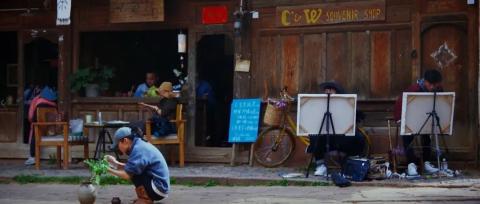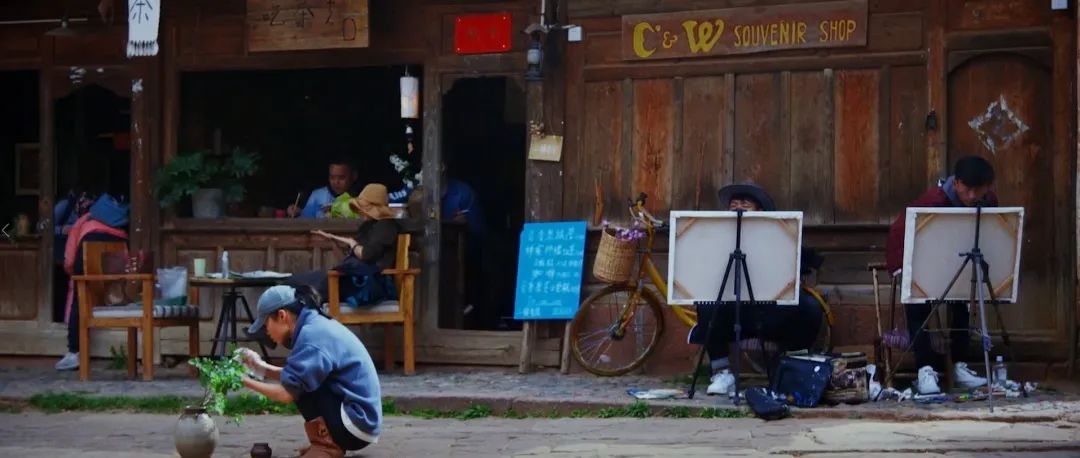


Shaxi is located in the southeast of Jianchuan County, Dali. The locals call it "Bazi", which means the plain between the valleys. During the Spring and Autumn Period and the Warring States Period, Shaxi became a bronze smelting base. Now, this small town hidden among the mountains and rivers still completely retains its past functional facilities and historical space. Around the Tang Dynasty, people began to dig well salt in Misha, which is separated by a mountain from Shaxi Bazi. Because Shaxi was closest to the salt well, a large number of salt-selling caravans from Tibet and northwest Yunnan came to Shaxi to trade. Shaxi Bazi began to become an important trading terminal on the Tea Horse Road, and "Sideng Sifang Street" was also formed during that period.


This was once an important stop on the Tea-Horse Ancient Road, where caravans rested, bringing fresh goods and stories from the outside. With the decline of the Tea Horse Road, this place was gradually forgotten. Because it has been forgotten, the style of the tea-horse town has been better preserved here. The ancient town is centered on Sifang Street, with four alleys in the southeast, northwest and northwest. The ground is made of ancient red sandstone slabs and there are various small shops on both sides of the streets. After the Ancient Tea-Horse Road gradually lost its former glory, many towns that prospered based on the ancient road either disappeared without a trace or changed beyond recognition. However, Shaxi still retains the past of prosperous trade on the "Ancient Tea-Horse Road" in Yunnan and Tibet.
Although the caravan culture with the camel bells has gradually faded away from here, the ancient town style that emerged due to the tea-horse trade, including the ancient stage, Xingjiao Temple, Sideng Street, and ancient stone bridges, are all perfectly preserved. In the blue sky, the clouds were rolling, and the sun was shining all over the town. The sunlight passing through the branches fell onto the ground and walls, creating a blur of light and shadow. The mottled walls of the old house and the blue-black tiled roof are covered with weeds. Time seems to have stopped a thousand years ago.


Ouyang Courtyard was built by Ouyang Jing, the leader of the caravan on the ancient Yunnan-Tibet Tea Horse Road (commonly known as Maguotou) in the late Qing Dynasty and the early Republic of China. It has a history of more than 100 years. In the past, commodity trade was formed between Yunnan and Tibet through inland residents exchanging tea, cloth, etc. with frontier people for high-quality horses, and Ouyang Jing was one of the leaders.
The Ouyang family was once prominent in the town, and the Ouyang Courtyard is a microcosm of the caravan culture on the Tea Horse Road. It is said that the ancestors of the Ouyang family moved to Shaxi from Luling, Jiangxi. There is a plaque sent by the government in the compound that reads "Xiu Jie Luling". The six wooden doors under the plaque are all carved by themselves, with one hundred "Fu" and one hundred "Shou" engraved in different fonts, which means hundreds of blessings and a hundred years of life. The old Ouyang Courtyard has a quaint charm. It is the inheritance of the material culture of traditional Chinese residences and a witness to the historical caravan culture.


Every Friday morning, there is a market in Shaxi Ancient Town. If you go to Shaxi, you must not miss that market. When I think of going to the market, I picture in my mind the bustling crowds, the dazzling array of daily necessities, fresh fruits and vegetables, the sounds of hawking and bargaining in the streets, and the smell of fireworks, just like a festive event.
Women carrying baskets, old ladies in colorful ethnic costumes, men standing in a pile smoking cigarettes, all kinds of nameless food, steaming shops... Going to the market is the best way to experience the life of the locals. Way. Many people come to Shaxi from all over to go to the market, buy some daily necessities, and then return to their small mountain village. Therefore, in addition to the Bai people, you can see many ethnic minorities in the market.


The ancient stage is the landmark building of Sifang Street and the most distinctive building. The main building of the ancient stage is Kuixing Pavilion. It is a three-story building with a stage in front and a high pavilion in the back. It has an exquisite structure. It has twelve corners and looks like flying wings. Although it has been repaired, it basically maintains the original architectural style.
It is located in the center of the building complex on the east side of Sifang Street, echoing the Xingjiao Temple on the west, forming a central axis that divides Sifang Street into two halves, north and south. The ancient stage represents a large part of the spiritual life of Shaxi people. Every traditional festival, residents of the town dress up in costumes, play the three-stringed dragon's head, and gather in Sifang Street to sing and dance.


People in Shaxi are proud to be able to perform on the ancient stage. It is said that there has always been such a rule in Shaxi - if you have not performed on the ancient stage, you cannot be called a Shaxi person. This shows the status of the ancient stage in the hearts of the locals. . Later, the ancient stage gradually became abandoned, and no one came to sing or listen to the opera anymore. The ancient stage sat silently on the streets of Shaxi Ancient Town, waiting for people who happened to pass by to discover its beauty. A friend of the Waiguo Basin, Bai Kun, discovered it and transformed it into a B&B with five rooms. The Stage Club is the new name of this B&B. Berquin often invited the village's Dongjing Ancient Orchestra to perform on the stage. He regrets: "If these old people leave, there may be no one to continue performing."
Shaxi Ancient Town attracts many history buffs, as well as tourists who pursue a simple lifestyle. Therefore, when you come to Shaxi, you must go to the ancient stage to listen to Dongjing ancient music, and see the Bai traditional Bawangbian and Xiaola. Only by dancing and listening to the tunes of the Bai people can you have a deeper appreciation of the charm of Shaxi.

